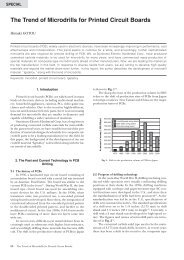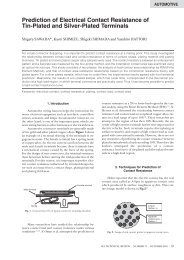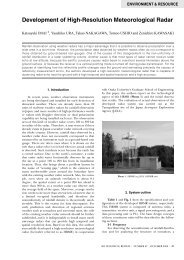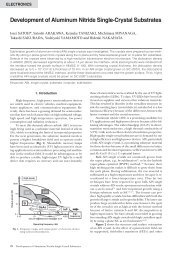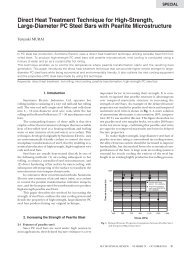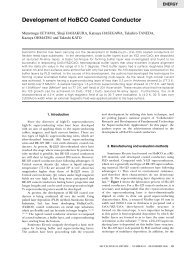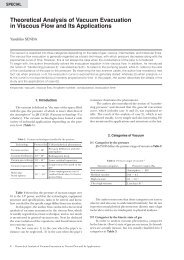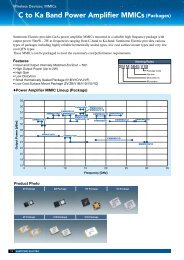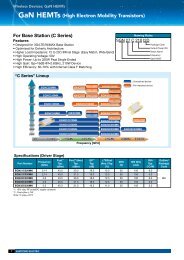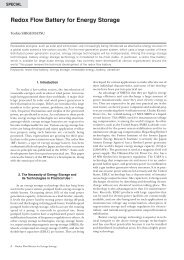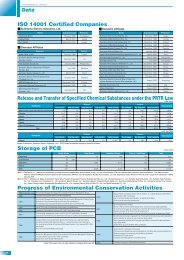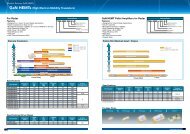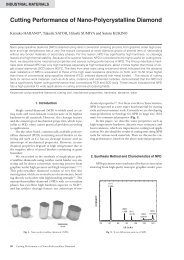Low-Loss and Low-Nonlinearity Pure-Silica-Core Fiber for Large ...
Low-Loss and Low-Nonlinearity Pure-Silica-Core Fiber for Large ...
Low-Loss and Low-Nonlinearity Pure-Silica-Core Fiber for Large ...
You also want an ePaper? Increase the reach of your titles
YUMPU automatically turns print PDFs into web optimized ePapers that Google loves.
INFORMATION & COMMUNICATIONS<br />
<strong>Low</strong>-<strong>Loss</strong> <strong>and</strong> <strong>Low</strong>-<strong>Nonlinearity</strong> <strong>Pure</strong>-<strong>Silica</strong>-<strong>Core</strong> <strong>Fiber</strong><br />
<strong>for</strong> <strong>Large</strong> Capacity Transmission<br />
Yoshinori YAMAMOTO*, Masaaki HIRANO <strong>and</strong> Takashi SASAKI<br />
This paper presents new low-loss <strong>and</strong> low-nonlinearity pure-silica-core fibers to be used <strong>for</strong> submarine <strong>and</strong> terrestrial<br />
long haul transmission systems. For large-capacity <strong>and</strong> ultra-long haul submarine systems, Z-PLUS <strong>Fiber</strong> LL with a loss<br />
of 0.162 dB/km <strong>and</strong> Z-PLUS <strong>Fiber</strong> 130 with a large effective area (Aeff) of 130 µm 2 are ideal due to their improved<br />
optical signal-to-noise ratio. For terrestrial long haul systems, on the other h<strong>and</strong>, <strong>Pure</strong>Advance-80 <strong>and</strong> <strong>Pure</strong>Advance-<br />
110 with a loss of 0.17 dB/km <strong>and</strong> an Aeff of 80 <strong>and</strong> 110 µm 2 respectively are advantageous due to their capabilities of<br />
long span length or long transmission reach.<br />
Keywords: pure-silica-core fiber, low loss, large effective area<br />
1. Introduction<br />
To keep up with the exponential growth of data network<br />
traffic, large transmission capacity per a fiber is<br />
strongly needed <strong>for</strong> optical communication systems. Recent<br />
progress in the transmission capacity mainly relies on<br />
multi-level modulation techniques with digital coherent detection.<br />
However, the larger capacity transmission over<br />
long distance requires higher optical signal-to-noise ratio<br />
(OSNR) (1) . Although there would be several techniques to<br />
improve the OSNR, the use of low-loss <strong>and</strong> low-nonlinearity<br />
fiber would be one of the most effective solutions to improve<br />
the OSNR (2) .<br />
<strong>Pure</strong>-silica-core fiber (PSCF), which has been known<br />
to have inherently low attenuation (3) , would be a promising<br />
c<strong>and</strong>idate <strong>for</strong> the low-loss <strong>and</strong> low-nonlinearity fiber. Since<br />
1980’s (4) , Sumitomo Electric Industries, Ltd. has continuously<br />
developed <strong>and</strong> proposed several types of PSCFs (5)-(9) ,<br />
including a record-low attenuation PSCF (5) . In fact, Sumitomo<br />
Electric has supplied PSCF products, Z <strong>Fiber</strong> <strong>and</strong> Z-<br />
PLUS <strong>Fiber</strong> <strong>for</strong> many years to submarine optical fiber cable<br />
industries by virtue of the low attenuation. However, there<br />
is a continuous need <strong>for</strong> lower attenuation <strong>and</strong> lower nonlinearity<br />
of fiber to realize further large capacity transmission<br />
over long distance. This is by no means a particular<br />
requirement <strong>for</strong> submarine applications. With the growing<br />
dem<strong>and</strong> <strong>for</strong> the large volume of data traffic, OSNR improvement<br />
with low-loss <strong>and</strong> low-nonlinearity fiber would<br />
become increasingly important <strong>for</strong> terrestrial long haul applications<br />
as well.<br />
In this paper, we first show that requirement <strong>for</strong> optical<br />
fibers have been dramatically changed to low loss <strong>and</strong> low<br />
nonlinearity. Then, we introduce Z-PLUS <strong>Fiber</strong> LL with<br />
lower attenuation <strong>and</strong> Z-PLUS <strong>Fiber</strong> 130 with lower nonlinearity<br />
as improved submarine PSCFs. Terrestrial PSCFs,<br />
<strong>Pure</strong>Advance-80 <strong>and</strong> <strong>Pure</strong>Advance-110 are also newly developed<br />
to support terrestrial long haul systems. In addition,<br />
we quantitatively discuss the impact on OSNR improvement<br />
of the low-loss <strong>and</strong> low-nonlinearity PSCFs, <strong>and</strong> present possible<br />
benefits <strong>for</strong> terrestrial long haul systems in views of the<br />
increase of span length or transmission distances.<br />
2. OSNR Improvement with <strong>Low</strong>-<strong>Loss</strong> <strong>and</strong><br />
<strong>Low</strong>-<strong>Nonlinearity</strong> <strong>Fiber</strong><br />
The needs <strong>for</strong> low-loss <strong>and</strong> low-nonlinearity fiber are<br />
rapidly increasing along with the recent progress of digital<br />
coherent techniques. In conventional systems, chromatic<br />
dispersion <strong>and</strong> polarization mode dispersion (PMD),<br />
which cause linear impairments of optical signal wave<strong>for</strong>ms,<br />
have been suppressed within the optical transmission<br />
line by using dispersion shifted fiber (DSF), non-zero<br />
dispersion shifted fiber (NZDSF) or dispersion compensating<br />
fiber (DCF). On the other h<strong>and</strong>, in the digital coherent<br />
systems, chromatic dispersion <strong>and</strong> PMD are no longer obstacles<br />
because the linear impairment due to the accumulated<br />
dispersion <strong>and</strong> PMD can be equalized by a digital<br />
signal processor at the digital coherent receiver. In consequence,<br />
higher OSNR becomes the most relevant requirement<br />
<strong>for</strong> the optical transmission line, <strong>and</strong> low attenuation<br />
<strong>and</strong> low nonlinearity of fiber are strongly required to improve<br />
the OSNR.<br />
Figure 1 shows the schematic of the OSNR improvement<br />
by low loss <strong>and</strong> low nonlinearity of fiber. OSNR at the<br />
receiver is given by the ratio of signal output power <strong>and</strong><br />
Tx<br />
<strong>Low</strong><br />
<strong>Nonlinearity</strong><br />
Signal Power<br />
Transmission <strong>Fiber</strong><br />
Nonlinear Impairment<br />
St<strong>and</strong>ard<br />
<strong>Fiber</strong><br />
Distance<br />
<strong>Low</strong>-<strong>Loss</strong> & <strong>Low</strong>-<br />
<strong>Nonlinearity</strong> <strong>Fiber</strong><br />
<strong>Low</strong><br />
Attenuation<br />
Noise<br />
Rx<br />
OSNR<br />
Fig. 1. Schematic of OSNR improvement by low attenuation <strong>and</strong><br />
low nonlinearity of fiber<br />
SEI TECHNICAL REVIEW · NUMBER 76 · APRIL 2013 · 63
noise level. <strong>Low</strong>er attenuation can directly increase the output<br />
power <strong>for</strong> a fixed input power. On the other h<strong>and</strong>, the<br />
signal input power is limited by nonlinear impairment because<br />
nonlinear phenomena due to Kerr effect in fiber,<br />
such as self-phase modulation (SPM), cross-phase modulation<br />
(XPM) <strong>and</strong> four wave mixing (FWM), cause the signal<br />
distortion with high input signal power. The lower nonlinearity<br />
of the fiber allows the higher threshold of the signal<br />
input power, <strong>and</strong> then improves the OSNR.<br />
Actually, at OFC/NFOEC2012, which is one of the<br />
largest technical conferences in the optical communication<br />
industry, all large-capacity (with a bit rate of higher than<br />
100 Gb/s per channel) <strong>and</strong> long-distance (with a transmission<br />
distance of longer than 1000 km) transmission experiments<br />
with digital coherent detection have used the<br />
low-loss <strong>and</strong> low-nonlinearity fibers as transmission lines<br />
without in-line dispersion compensation (10) .<br />
3. Characteristics of <strong>Low</strong>-<strong>Loss</strong> <strong>and</strong><br />
<strong>Low</strong>-<strong>Nonlinearity</strong> PSCFs<br />
3-1 <strong>Low</strong>-loss <strong>and</strong> low-nonlinearity PSCFs<br />
Table 1 shows the lineup of our PSCFs <strong>and</strong> their typical<br />
characteristics at wavelength of 1550 nm. Among the<br />
PSCFs listed in Table 1, Z <strong>Fiber</strong> <strong>and</strong> Z-PLUS <strong>Fiber</strong> have<br />
been supplied to submarine optical fiber cable industries<br />
since 1980’s. Here, we introduce improved submarine<br />
PSCFs, Z-PLUS <strong>Fiber</strong> LL with lowered attenuation of 0.162<br />
dB/km <strong>and</strong> Z-PLUS <strong>Fiber</strong> 130 with larger effective area<br />
(Aeff) of 130 µm 2 to further reduce the nonlinearity.<br />
<strong>Pure</strong>Advance-80 <strong>and</strong> <strong>Pure</strong>Advance-110 have also been<br />
newly developed to support terrestrial long haul systems.<br />
<strong>Pure</strong>Advance-80, which is fully compliant with ITU-T G.652<br />
recommendation, has the lower attenuation of 0.17 dB/km,<br />
while keeping the compatibility with st<strong>and</strong>ard single mode<br />
fiber (SSMF). <strong>Pure</strong>Advance-110 has the enlarged Aeff of<br />
110 µm 2 to reduce the nonlinearity, <strong>and</strong> it would be suitable<br />
<strong>for</strong> longer distance <strong>and</strong> larger capacity transmission in terrestrial<br />
networks.<br />
In the following subsections, we introduce the technologies<br />
<strong>for</strong> reduction of the fiber attenuation <strong>and</strong> nonlinearity.<br />
3-2 Reduction of fiber attenuation<br />
In order to reduce the fiber attenuation, it is essential<br />
to reduce the Rayleigh scattering loss that dominates about<br />
80% of the fiber attenuation at 1550 nm. Rayleigh scattering<br />
results from the dopant concentration fluctuation <strong>and</strong><br />
the density fluctuation of the glass composition. There<strong>for</strong>e,<br />
the use of pure-silica glass with no dopant as the core must<br />
be the best solution to eliminate the dopant concentration<br />
fluctuation. Whereas the Rayleigh scattering coefficient<br />
<strong>and</strong> the attenuation of SSMF with GeO2-doped core are<br />
typically 0.94 dB/km/µm -4 <strong>and</strong> 0.19 dB/km at 1550 nm,<br />
those of Z-PLUS <strong>Fiber</strong> are 0.84 dB/km/µm -4 <strong>and</strong> 0.168<br />
dB/km, respectively. In addition, by suppressing the density<br />
fluctuation in PSCF, we have realized the mass production<br />
of Z-PLUS <strong>Fiber</strong> LL with the attenuation of as low as<br />
0.162 dB/km <strong>and</strong> Rayleigh scattering coefficient of 0.80<br />
dB/km/µm -4 . Figure 2 shows the attenuation spectra of<br />
Attenuation [dB/km]<br />
0.5<br />
0.4<br />
0.3<br />
0.2<br />
SSMF: 0.19dB/km<br />
Z-PLUS <strong>Fiber</strong><br />
St<strong>and</strong>ard: 0.168dB/km<br />
<strong>Low</strong> <strong>Loss</strong>: 0.162dB/km<br />
at 1550nm<br />
0.1<br />
1300 1350 1400 1450 1500 1550 1600 1650<br />
Wavelength [nm]<br />
Fig. 2. Attenuation spectra of SSMF, Z-PLUS <strong>Fiber</strong> <strong>and</strong> Z-PLUS <strong>Fiber</strong> LL<br />
Application<br />
Table 1. Sumitomo Electric low-loss <strong>and</strong> low-nonlinearity PSCFs <strong>and</strong> their typical characteristics at 1550 nm<br />
Long haul / metro<br />
/ access (reference)<br />
Submarine<br />
Terrestrial Long-Haul<br />
Product Name <strong>Pure</strong>B<strong>and</strong> Z <strong>Fiber</strong> Z-PLUS <strong>Fiber</strong> Z-PLUS <strong>Fiber</strong> 130 <strong>Pure</strong>Advance-80 <strong>Pure</strong>Advance-110<br />
ITU-T Rec. G.652.D G.654.C G.654.B G.654.B G.652.B G.654.B<br />
Refractive<br />
Index Profile<br />
Step Step Depressed<br />
Cladding<br />
GeO2-SiO2<br />
Depressed<br />
Cladding<br />
Step<br />
SiO2<br />
Depressed<br />
Cladding<br />
Attenuation<br />
[dB/km]<br />
0.19 0.170<br />
0.168 (Std.)<br />
0.162 (LL)<br />
0.162 0.17 0.168<br />
Aeff [µm 2 ] 80 78 112 130 80 110<br />
n2 [×10 -20 m 2 /W] 2.34 2.2 2.2 2.2 2.2 2.2<br />
Dispersion<br />
[ps/nm/km]<br />
17 18.5 20.5 20.5 16 20.5<br />
F-SiO2<br />
64 · <strong>Low</strong>-<strong>Loss</strong> <strong>and</strong> <strong>Low</strong>-<strong>Nonlinearity</strong> <strong>Pure</strong>-<strong>Silica</strong>-<strong>Core</strong> <strong>Fiber</strong> <strong>for</strong> <strong>Large</strong> Capacity Transmission
SSMF, Z-PLUS <strong>Fiber</strong> <strong>and</strong> Z-PLUS <strong>Fiber</strong> LL.<br />
3-3 Reduction of fiber nonlinearity<br />
The nonlinear coefficient of fiber γ [1/W/km] is given by<br />
..................................... (1)<br />
where n2 [m 2 /W] is an nonlinear refractive index, Aeff<br />
[µm 2 ] is an effective area, λ [nm] is wavelength. From<br />
Eq.(1), there would be two approaches to reduce the fiber<br />
nonlinearity. One is the reduction of n2 to reduce the nonlinearity<br />
of the glass material itself. Another one is the enlargement<br />
of Aeff to reduce the optical power density in<br />
the core. Since PSCF generally has about 9% lower n2 than<br />
SSMF (11) , PSCF would also be preferable to reduce the fiber<br />
nonlinearity.<br />
The enlargement of Aeff would be mainly limited by<br />
degradations of the macro- <strong>and</strong> microbending per<strong>for</strong>mances<br />
because the light confinement in the core becomes weaker<br />
<strong>for</strong> larger Aeff fibers. In order to improve the macrobending<br />
per<strong>for</strong>mances of large Aeff fibers, we have employed depressed<br />
cladding index profile <strong>for</strong> Z-PLUS <strong>Fiber</strong>, Z-PLUS<br />
<strong>Fiber</strong> 130 <strong>and</strong> <strong>Pure</strong>Advance-110, as shown in Table 1.<br />
On the other h<strong>and</strong>, the microbending loss is caused<br />
by small r<strong>and</strong>om de<strong>for</strong>mations of the fiber axis in an installed<br />
cable. We have applied a lower Young’s modulus<br />
primary coating to mitigate the de<strong>for</strong>mation of the fiber (8) .<br />
Figure 3 shows the measured microbending losses as a<br />
function of Aeff <strong>for</strong> fibers with the low modulus <strong>and</strong> conventional<br />
primary coatings. Here, the microbending loss<br />
was characterized by a wire mesh bobbin test with wound<br />
tension of 80 g (12) . Although the microbending loss increases<br />
with larger Aeff, the lower modulus coating can significantly<br />
reduce the microbending loss compared to that<br />
with the conventional coating, as shown in Fig. 3. By applying<br />
the lower modulus coating, we have successfully developed<br />
Z-PLUS <strong>Fiber</strong> 130 with enlarged Aeff of 130 µm 2<br />
while keeping the equivalent microbending per<strong>for</strong>mance<br />
to Z-PLUS <strong>Fiber</strong> with conventional coating that has been<br />
deployed in actual submarine cables <strong>for</strong> many years (8) .<br />
Microbending <strong>Loss</strong><br />
at 1550nm [dB/km]<br />
= 2 π<br />
γ<br />
n2<br />
λ Aeff<br />
10<br />
1<br />
0.1<br />
Z-PLUS <strong>Fiber</strong><br />
0.01<br />
60 80 100 120 140 160<br />
Aeff [µm 2 ]<br />
Conventional<br />
coating<br />
<strong>Low</strong> modulus<br />
primary<br />
coating<br />
Z-PLUS <strong>Fiber</strong> 130<br />
Fig. 3. Microbending loss <strong>for</strong> fibers with low Young’s modulus primary <strong>and</strong><br />
conventional coatings<br />
3-4 Long haul <strong>and</strong> large capacity transmission experiments<br />
with the low-loss <strong>and</strong> low-nonlinearity PSCFs<br />
The transmission per<strong>for</strong>mances of the low-loss <strong>and</strong> lownonlinearity<br />
PSCFs have been experimentally demonstrated<br />
by several system suppliers. Table 2 summarizes the recently-reported<br />
long haul <strong>and</strong> large capacity transmission<br />
experiments with digital coherent detection using our<br />
PSCFs. References 13 <strong>and</strong> 14 have demonstrated ultra-long<br />
haul transmissions of 100 Gb/s signals over more than 7000<br />
km (13),(14) . Here, dual polarization quadrature phase shift<br />
keying (DP-QPSK), which started commercial operations as<br />
the suitable <strong>for</strong>mat <strong>for</strong> 100 Gb/s line rate, has been used.<br />
The record distance of 462 km <strong>for</strong> 100 Gb/s unrepeated<br />
transmission has also been achieved (15) . As a next generation<br />
signal <strong>for</strong>mat, DP-16-state quadrature amplitude modulation<br />
(DP-16QAM) would be a promising solution to<br />
increase the line rate to 200 Gb/s or 400 Gb/s. DP-16QAM<br />
signals have been transmitted over longer than 1200 km, indicating<br />
the feasibility of applying the <strong>for</strong>mat to terrestrial<br />
long haul systems (16),(17) . The record capacity <strong>and</strong> distance<br />
products <strong>for</strong> unrepeated transmission have also been<br />
demonstrated with DP-16QAM <strong>for</strong>mat <strong>and</strong> Z-PLUS <strong>Fiber</strong><br />
130 (18) . Furthermore, our PSCF has also been used <strong>for</strong> 1<br />
Tb/s superchannel transmission (19) , which is actively studied<br />
as a future large capacity transmission technology.<br />
Table 2. Recently-reported long haul <strong>and</strong> large capacity transmission<br />
experiments with the low-loss <strong>and</strong> low-nonlinearity PSCFs<br />
Ref. <strong>Fiber</strong> Experiments<br />
(13) Z-PLUS <strong>Fiber</strong><br />
(14)<br />
(15)<br />
(16)<br />
(17)<br />
(18)<br />
Z-PLUS<br />
<strong>Fiber</strong> 130<br />
Z-PLUS<br />
<strong>Fiber</strong> 130<br />
Z-PLUS<br />
<strong>Fiber</strong> 130<br />
Z-PLUS<br />
<strong>Fiber</strong> 130<br />
Z-PLUS<br />
<strong>Fiber</strong> 130<br />
(19) Z-PLUS <strong>Fiber</strong><br />
155ch × 100Gb/s DP-QPSK<br />
7,200km Transmission<br />
11ch × 112Gb/s DP-QPSK<br />
8,500km Transmission<br />
4ch × 100Gb/s DP-QPSK<br />
462km Unrepeated Transmission<br />
16ch × 224Gb/s DP-16QAM<br />
1,280km Transmission<br />
5ch × 448Gb/s dual-carrier DP-16QAM<br />
1,230km Transmission<br />
80ch × 224Gb/s DP-16QAM<br />
240km Unrepeated Transmission<br />
1Tb/s-Superchannel<br />
(10ch × 120G-DP-QPSK)<br />
10,000km Transmission<br />
4. Splice Per<strong>for</strong>mance of <strong>Low</strong>-<strong>Loss</strong> <strong>and</strong><br />
<strong>Low</strong>-<strong>Nonlinearity</strong> PSCF<br />
Whereas the enhancement of Aeff is an effective way<br />
to reduce the nonlinearity as described so far, it is noted<br />
that much larger Aeff may degrade dissimilar splice loss to<br />
SSMF unacceptably due to the larger mismatching of mode<br />
field diameter (MFD). In actual systems, both ends of a<br />
transmission fiber would be spliced to SSMF because most<br />
of pigtails of optical amplifiers <strong>and</strong> equipment are made<br />
with SSMF today. If the dissimilar splice loss to SSMF be-<br />
SEI TECHNICAL REVIEW · NUMBER 76 · APRIL 2013 · 65
comes larger, OSNR of the system can be degraded eventually.<br />
There<strong>for</strong>e, dissimilar splice loss to SSMF would be<br />
also one of the important fiber properties.<br />
We have here examined the splice loss between lowloss<br />
<strong>and</strong> low-nonlinearity PSCFs <strong>and</strong> SSMF with Aeff of 80<br />
µm 2 by using a commercial fusion splicer with a SMF-st<strong>and</strong>ard<br />
setting. Figure 4 shows the measured average, maximum<br />
<strong>and</strong> minimum splice losses <strong>for</strong> each set of 20 splices.<br />
A solid curve in Fig. 4 shows the dissimilar splice loss calculated<br />
from the degradation of the coupling efficiency<br />
due to the MFD mismatching. As shown in Fig. 4, the splice<br />
loss is mainly caused by the MFD mismatching, which<br />
would be unavoidable <strong>for</strong> the larger Aeff fibers. The average<br />
splice loss <strong>for</strong> <strong>Pure</strong>Advance-110 <strong>and</strong> Z-PLUS <strong>Fiber</strong> 130<br />
are about 0.1 dB <strong>and</strong> 0.2 dB, respectively. Meanwhile, the<br />
splice loss would be increased to more than 0.3 dB <strong>for</strong><br />
fibers with Aeff larger than 150 µm 2 . In addition, considering<br />
the loss increase due to the cabling or packaging <strong>for</strong><br />
much larger Aeff fiber, Aeff of 110-130 µm 2 would be appropriate<br />
<strong>for</strong> practical use.<br />
total distance divided by the span length), respectively. C<br />
is a non-fiber coefficient determined by the transmission<br />
system. The right side of Eq.(2) correspond to the effects<br />
of large dispersion, low nonlinearity, low attenuation <strong>and</strong><br />
low dissimilar splice loss, <strong>and</strong> degradation due to accumulated<br />
amplifier noise from repeaters, respectively. It is also<br />
noted that larger chromatic dispersion would be more<br />
preferable to suppress the phase matching between signal<br />
channels <strong>and</strong> then reduce the nonlinear impairment. By<br />
using Eq.(2), Fig. 5 shows a contour map of the relative<br />
OSNR normalized to that <strong>for</strong> SSMF (α = 0.19 dB/km, D =<br />
17 ps/nm/km, Aeff = 80 µm 2 , n2 = 2.34 × 10 -20 m 2 /W) as a<br />
function of Aeff <strong>and</strong> attenuation <strong>for</strong> a transmission link<br />
with a total distance of 1500 km <strong>and</strong> a span length L of 80<br />
km. Here, D <strong>and</strong> n2 are fixed to 21 ps/nm/km <strong>and</strong> 2.2 ×<br />
10 -20 m 2 /W, respectively. From Fig. 5, both of low attenuation<br />
<strong>and</strong> large Aeff are beneficial to increase the OSNR. Z-<br />
PLUS <strong>Fiber</strong> LL <strong>and</strong> Z-PLUS <strong>Fiber</strong> 130 are expected to have<br />
2.7 dB <strong>and</strong> 3.1 dB OSNR improvement compared to SSMF,<br />
respectively.<br />
Dissimilar Splice loss to SSMF [dB]<br />
0.4<br />
0.3<br />
0.2<br />
0.1<br />
Measured<br />
<strong>Pure</strong>Advance-80<br />
<strong>Pure</strong>Advance-110<br />
Max.<br />
Z-PLUS<br />
<strong>Fiber</strong> 130<br />
0<br />
60 80 100 120 140 160<br />
Aeff [µm 2 ]<br />
Ave.<br />
Min.<br />
Calculated<br />
Fig. 4. Splice loss between low-loss <strong>and</strong> low-nonlinearity PSCFs <strong>and</strong> SSMF<br />
Aeff [µm 2 ]<br />
160<br />
140<br />
120<br />
100<br />
+4dB<br />
Z-PLUS <strong>Fiber</strong> LL<br />
+3dB<br />
Z-PLUS <strong>Fiber</strong> 130<br />
80<br />
0.14 0.15 0.16 0.17 0.18 0.19<br />
Attenuation [dB/km]<br />
Z-PLUS <strong>Fiber</strong><br />
<strong>Pure</strong>Advance-110<br />
Z <strong>Fiber</strong><br />
<strong>Pure</strong>Advance-80<br />
+2dB<br />
OSNR<br />
+1dB<br />
Fig. 5. Relative OSNR normalized to that <strong>for</strong> SSMF in a 1500km-reach<br />
transmission link with 80km-span<br />
5. Possible Benefits of <strong>Low</strong>-<strong>Loss</strong> <strong>and</strong><br />
<strong>Low</strong>-<strong>Nonlinearity</strong> PSCFs on<br />
Transmission Systems<br />
5-1 Impact on OSNR improvement<br />
The amount of OSNR improvement is quantitatively<br />
discussed to compare the transmission per<strong>for</strong>mances of<br />
low-loss <strong>and</strong> low-nonlinearity fibers in digital coherent systems.<br />
Maximized OSNR (OSNRmax) <strong>for</strong> transmission fibers<br />
having different characteristics has been analytically <strong>for</strong>mulated<br />
(20) , <strong>and</strong> can be described as<br />
10<br />
20<br />
OSNRmax [dB] = log (|D| × L eff) – log ( γ ×<br />
3<br />
3<br />
Leff)<br />
.... (2)<br />
– 2 2<br />
α<br />
3<br />
L – α<br />
3<br />
sp – 10log (Ns) + C<br />
where D [ps/nm/km], Leff [km], α [dB/km], L [km], αsp<br />
[dB], Ns are chromatic dispersion, effective length, fiber<br />
attenuation, span length (distance between repeaters), dissimilar<br />
splice loss to SSMF, <strong>and</strong> the number of spans (the<br />
5-2 Increase in transmission distance with low-loss <strong>and</strong><br />
low-nonlinearity PSCF<br />
OSNRmax in Eq.(2) would be directly correlated to the<br />
maximum feasible transmission distance <strong>and</strong> span length.<br />
There<strong>for</strong>e, the maximized span length or transmission distance<br />
can be predicted from Eq.(2) <strong>for</strong> different fibers with<br />
a same transmission system by using the fiber parameters,<br />
such as attenuation, Aeff, chromatic dispersion, <strong>and</strong> dissimilar<br />
splice loss (20) . We calculate the impact on the increase in<br />
the maximum span length <strong>and</strong> transmission distance of<br />
<strong>Pure</strong>Advance-80 <strong>and</strong> <strong>Pure</strong>Advance-110 in terrestrial long<br />
haul systems. It is noted that the length of cable on a single<br />
spool would be generally limited to a few km in actual terrestrial<br />
transmission lines, <strong>and</strong> there would be a lot of cable<br />
splice points. There<strong>for</strong>e, the loss increase due to the cable<br />
splice should be considered. For example, field installed<br />
cable with an average loss of 20.8 dB per 79.1 km-long span,<br />
which is equal to 0.26 dB/km, has been reported (21) . Since<br />
the typical loss of today’s SSMF is about 0.19 dB/km, the loss<br />
66 · <strong>Low</strong>-<strong>Loss</strong> <strong>and</strong> <strong>Low</strong>-<strong>Nonlinearity</strong> <strong>Pure</strong>-<strong>Silica</strong>-<strong>Core</strong> <strong>Fiber</strong> <strong>for</strong> <strong>Large</strong> Capacity Transmission
increase in field installed cable is assumed to be +0.07<br />
dB/km <strong>for</strong> every fiber in our calculations.<br />
Figure 6 shows the calculated maximum span length in<br />
a 1500 km-long link transmitting 100 Gb/s DP-QPSK signals<br />
<strong>for</strong> SSMF, NZDSF (α = 0.20 dB/km, D = 4.0 ps/nm/km,<br />
Aeff = 70 µm 2 , n2 = 2.36 × 10 -20 m 2 /W), <strong>Pure</strong>Advance-80, <strong>and</strong><br />
<strong>Pure</strong>Advance-110. The maximum span length is decided<br />
after Eq.(2) assuming the Q-factor of 11 dB. We calculate<br />
the maximum span length <strong>for</strong> both with <strong>and</strong> without distributed<br />
Raman amplification (DRA). 2 dB OSNR improvement<br />
is considered <strong>for</strong> links with DRA. From Fig. 6, whereas<br />
the span length <strong>for</strong> SSMF is 96 km with DRA, <strong>Pure</strong>Advance-<br />
110 can increase the span length to 102 km without DRA.<br />
In addition, the span length can be extended to 119 km by<br />
combining DRA. This means the considerable increase in<br />
span length of 21 km <strong>and</strong> 44 km compared to SSMF <strong>and</strong><br />
NZDSF, respectively.<br />
140<br />
120<br />
: without : with<br />
Distributed Raman Amplification<br />
2600 km without DRA, <strong>and</strong> it can reach to 4200 km or<br />
longer by combining DRA. The distances correspond to as<br />
much as 1.7 times <strong>and</strong> 3.4 times of those of SSMF <strong>and</strong><br />
NZDSF, respectively. From these results, <strong>Pure</strong>Advance-110<br />
should be best suited to terrestrial long haul systems due<br />
to the capability of significant increase in span length or<br />
transmission distance.<br />
6. Conclusion<br />
We have introduced newly-developed low-loss <strong>and</strong> lownonlinearity<br />
PSCFs <strong>for</strong> large capacity transmission systems<br />
with digital coherent detection. In addition, the possible<br />
benefits in significant increase of the span length or transmission<br />
distance have been presented based on the OSNR<br />
improvement. <strong>Low</strong>-loss <strong>and</strong> low-nonlinearity PSCFs are<br />
most promising <strong>for</strong> next generation fiber to support long<br />
haul <strong>and</strong> large capacity transmissions in both submarine<br />
<strong>and</strong> terrestrial long haul systems.<br />
Span Length [km]<br />
100<br />
80<br />
60<br />
· Z <strong>Fiber</strong>, Z-PLUS <strong>Fiber</strong>, <strong>Pure</strong> Advance <strong>and</strong> <strong>Pure</strong> B<strong>and</strong> are trademarks or<br />
registered trademarks of Sumitomo Electric Industries, Ltd.<br />
40<br />
SSMF NZDSF <strong>Pure</strong>Advance<br />
-80<br />
<strong>Pure</strong>Advance<br />
-110<br />
Fig. 6. Maximum span length <strong>for</strong> a 1500km transmission link with 100 Gb/s<br />
DP-QPSK <strong>for</strong>mat<br />
Figure 7 shows the calculated maximum transmission<br />
distance with a fixed span length of 80 km <strong>for</strong> 100 Gb/s<br />
DP-QPSK signals. From Fig. 7, <strong>Pure</strong>Advance-110 can increase<br />
the maximum transmission distance to longer than<br />
Distance [km]<br />
5,000<br />
4,000<br />
3,000<br />
2,000<br />
1,000<br />
0<br />
: without : with<br />
Distributed Raman Amplification<br />
SSMF NZDSF <strong>Pure</strong>Advance<br />
-80<br />
<strong>Pure</strong>Advance<br />
-110<br />
Fig. 7. Maximum transmission distance <strong>for</strong> a 80 km-span link with 100 Gb/s<br />
DP-QPSK <strong>for</strong>mat<br />
References<br />
(1) D. van den Borne, V. Sleiffer, M. S. Alfiad, S. L. Jansen, “Towards<br />
400G <strong>and</strong> beyond: how to design the next generation of ultra-high<br />
capacity transmission systems,” OECC2011, 7B4_1 (July, 2011)<br />
(2) Y. Yamamoto, M. Hirano <strong>and</strong> T. Sasaki, “A New Class of Optical <strong>Fiber</strong><br />
to Support <strong>Large</strong> Capacity Transmission,” OFC/NFOEC2011, OWA6<br />
(Mar. 2011)<br />
(3) Y. Chigusa, Y. Yamamoto, T. Yokokawa, T. Sasaki, T. Taru, M. Hirano,<br />
M. Kakui, M. Onishi, <strong>and</strong> E. Sasaoka, “<strong>Low</strong>-<strong>Loss</strong> <strong>Pure</strong>-<strong>Silica</strong>-<strong>Core</strong><br />
<strong>Fiber</strong>s <strong>and</strong> Their Possible Impact on Transmission Systems,” J. Lightwave<br />
Technol, vol.23, no.11, pp.3541-3550 (Nov. 2005)<br />
(4) H. Kanamori, H. Yokota, G. Tanaka, M. Watanabe, Y. Ishiguro,<br />
I. Yoshida, T. Kakii, S. Itoh, Y. Asano, <strong>and</strong> S. Tanaka, “Transmission<br />
Characteristics <strong>and</strong> Reliability of <strong>Pure</strong>-<strong>Silica</strong>-<strong>Core</strong> Single-Mode <strong>Fiber</strong>s,”<br />
J. Lightwave Technol., vol.LT-4, no.8, pp.1144-1150 (Aug. 1986)<br />
(5) K. Nagayama, M. Kakui, M. Matsui, T. Saitoh <strong>and</strong> Y. Chigusa,“Ultralow-loss<br />
(0.1484 dB/km) pure silica core single mode fibres <strong>and</strong><br />
extension of transmission distance,” Electron. Lett., vol.38, no.20,<br />
pp.1168-1169 (2002)<br />
(6) T. Kato, M. Hirano, M. Onishi <strong>and</strong> M. Nishimura, “Ultra-low nonlinearity<br />
low-loss pure silica core fibre <strong>for</strong> long-haul WDM transmission,”<br />
Electron. Lett., vol.35, no.19, pp.1615-1617 (Sept. 1999)<br />
(7) Y. Yamamoto, T. Sasaki, T. Taru, M. Hirano, S. Ishikawa, M. Onishi,<br />
E. Sasaoka, <strong>and</strong> Y. Chigusa, “Water-free pure-silica-core fibre <strong>and</strong> its<br />
stability against hydrogen ageing,” Electron. Lett. vol.40, no.22,<br />
pp.1401-1403 (Oct. 2004).<br />
(8) Y. Yamamoto, M. Hirano, K. Kuwahara, <strong>and</strong> T. Sasaki, “OSNR-Enhancing<br />
<strong>Pure</strong>-<strong>Silica</strong>-<strong>Core</strong> <strong>Fiber</strong> with <strong>Large</strong> Effective Area <strong>and</strong> <strong>Low</strong> Attenuation,”<br />
OFC/NFOEC2010, OTuI2 (Mar. 2010)<br />
(9) M. Hirano, Y. Yamamoto, Y. Tamura, T. Haruna <strong>and</strong> T. Sasaki, “Aeffenlarged<br />
<strong>Pure</strong>-<strong>Silica</strong>-<strong>Core</strong> <strong>Fiber</strong> having Ring-<strong>Core</strong> Profile,”<br />
OFC/NFOEC2012, OTh4I.2 (Mar. 2012)<br />
SEI TECHNICAL REVIEW · NUMBER 76 · APRIL 2013 · 67
(10) T. Kobayashi, A. Sano, A. Matsuura, Y. Miyamoto <strong>and</strong> K. Ishihara,<br />
“Nonlinear tolerant long-haul WDM transmission over 1200km<br />
using 538Gb/s/ch PDM-64QAM SC-FDM signals with pilot tone,”<br />
OFC/NFOEC2012, OM2A.5 (Mar.2012)<br />
(11) T. Kato, Y. Suetsugu, <strong>and</strong> M. Nishimura, “Estimation of nonlinear refractive<br />
index in various silica-based glasses <strong>for</strong> optical fibers,” Opt.<br />
Lett. vol.20, no.22, pp.279-2281 (Nov. 1995)<br />
(12) J.F. Libert, J.L. Lang, <strong>and</strong> L. Chesnoy, “The New 160 Gigabit WDM<br />
Challenge <strong>for</strong> Submarine Cable Systems,” Proc. IWCS1998, pp. 375-<br />
384 (Nov. 1998)<br />
(13) M. Salsi, H. Mardoyan, P. Tran, C. Koebele, E. G. Charlet, S. Bigo,<br />
“155 × 100 Gbit/s coherent PDM-QPSK transmission over 7,200km,”<br />
Proc. ECOC2009, PD2.5 (Sept. 2009)<br />
(14) V. A. J. M. Sleiffer, D. van den Borne, M. Kuschnerov, V. Veljanovski,<br />
M. Hirano, Y. Yamamoto, T. Sasaki, S. L. Jansen, <strong>and</strong> H. de Waardt, “A<br />
comparison between SSMF <strong>and</strong> large-Aeff <strong>Pure</strong>-<strong>Silica</strong> core fiber <strong>for</strong> Ultra<br />
Long-Haul 100G transmission,” ECOC2011, Mo.2.B.6 (Sept. 2011)<br />
(15) H. Bissessur, P. Bousselet, D. Mongardien, G. Boissy, J. Lestrade, “4 ×<br />
100Gb/s Unrepeatered Transmission over 462 km Using Coherent<br />
PDM-QPSK Format <strong>and</strong> Real-Time Processing,” ECOC2011, Tu.3.B.3<br />
(Sept. 2011)<br />
(16) S. Oda, T. Tanimura, T. Hoshida, Y. Akiyama, H. Nakashima, K. Sone,<br />
Y. Aoki, W. Yan, Z. Tao, L. Dou, L. Li, J. C. Rasmussen, Y. Yamamoto,<br />
<strong>and</strong> T. Sasaki, “Experimental Investigation on Nonlinear Distortions<br />
with Perturbation Back-Propagation Algorithm in 224 Gb/s DP-<br />
16QAM Transmission,” OFC/NFOEC2012, OM3A.2 (Mar. 2012)<br />
(17) V. A. J. M. Sleiffer, D. van den Borne, V. Veljanovski, M. Kuschnerov,<br />
M. Hirano, Y. Yamamoto, T. Sasaki, S.L. Jansen, <strong>and</strong> H. de Waardt,<br />
“Transmission of 448-Gb/s Dual-Carrier POLMUX-16QAM Over<br />
1230 km with 5 Flexi-Grid ROADM Passes,” OFC/NFOEC2012,<br />
OW4C.3 (Mar.2012)<br />
(18) S. Oda, T. Tanimura, Y. Cao, T. Hoshida, Y. Akiyama, H. Nakashima,<br />
C. Ohshima, K. Sone, Y. Aoki, M. Yan, Z. Tao, J. C. Rasmussen,<br />
Y. Yamamoto, <strong>and</strong> T. Sasaki, “80 × 224 Gb/s Unrepeated Transmission<br />
over 240 km of <strong>Large</strong>-Aeff <strong>Pure</strong> <strong>Silica</strong> <strong>Core</strong> Fibre without Remote<br />
Optical Pre-amplifier,” ECOC2011, Th.13.C.7 (Sept. 2011)<br />
(19) E. Torrengo, R. Cigliutti, G. Bosco, G. Gavioli, A. Alaimo, A. Carena,<br />
V. Curri, F. Forghieri, S. Piciaccia, M. Belmonte, A. Brinciotti, A. La<br />
Porta, S. Abrate, P. Poggiolini, “Transoceanic PM-QPSK Terabit Superchannel<br />
Transmission Experiments at Baud-Rate Subcarrier Spacing,”<br />
ECOC2011, We.7.C.2 (Sept. 2011)<br />
(20) M. Hirano, Y. Yamamoto, V. A. J. M. Slieffer <strong>and</strong> T. Sasaki, “Analytical<br />
OSNR Formulation Validated with 100 G-WDM Experiments <strong>and</strong> Optimal<br />
Subsea <strong>Fiber</strong> Proposal,” OFC/NFOEC2013, OTu2B.6 (Mar. 2013)<br />
(21) T. J. Xia, G. A. Wellbrock, Y-K. Huang, E. Ip, M-F. Huang, Y. Shao,<br />
T. Wang, Y. Aono, T. Tajima, S. Murakami, <strong>and</strong> M. Cvijetic, “Field Experiment<br />
with Mixed Line-Rate Transmission (112-Gb/s, 450-Gb/s, <strong>and</strong><br />
1.15-Tb/s) over 3,560 km of Installed <strong>Fiber</strong> Using Filterless Coherent<br />
Receiver <strong>and</strong> EDFAs Only,” OFC/NFOEC2011, PDPA3 (Mar. 2011)<br />
Contributors (The lead author is indicated by an asterisk (*).)<br />
Y. YAMAMOTO*<br />
• Assistant Manager, Optical Communications<br />
R&D Laboratories<br />
M. HIRANO<br />
• Assistant General Manager, Optical Communications<br />
R&D Laboratories<br />
T. SASAKI<br />
• Group Manager, Optical Communications R&D Laboratories<br />
68 · <strong>Low</strong>-<strong>Loss</strong> <strong>and</strong> <strong>Low</strong>-<strong>Nonlinearity</strong> <strong>Pure</strong>-<strong>Silica</strong>-<strong>Core</strong> <strong>Fiber</strong> <strong>for</strong> <strong>Large</strong> Capacity Transmission



